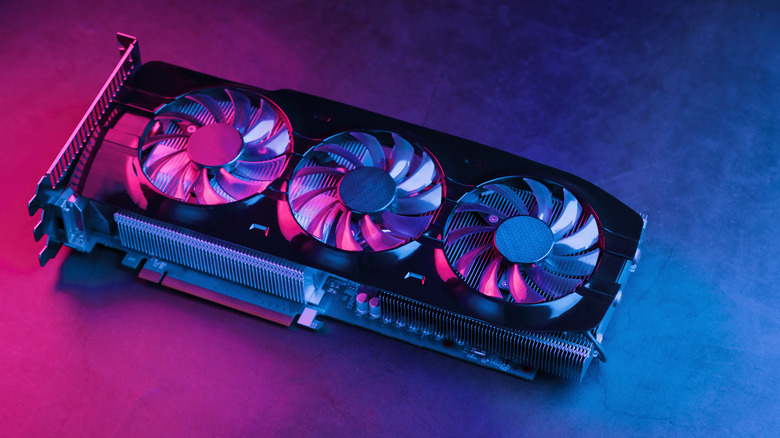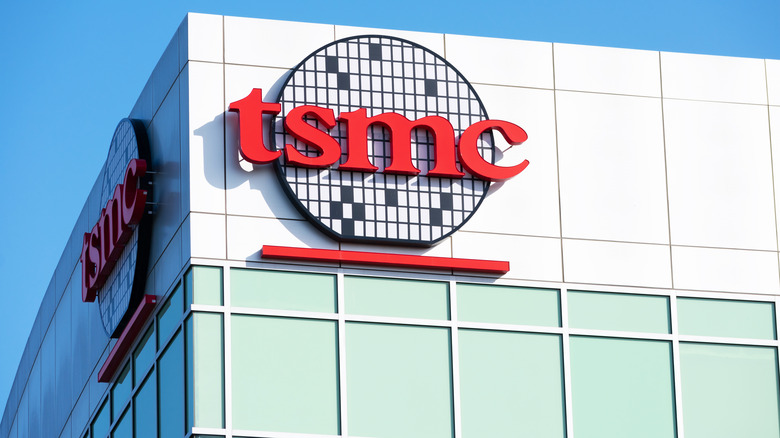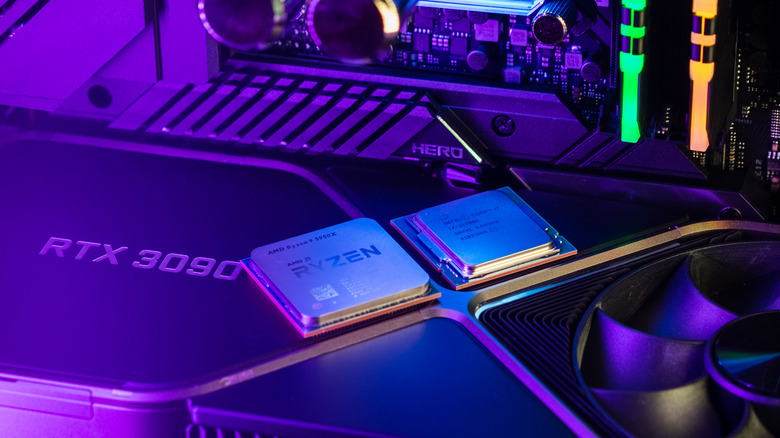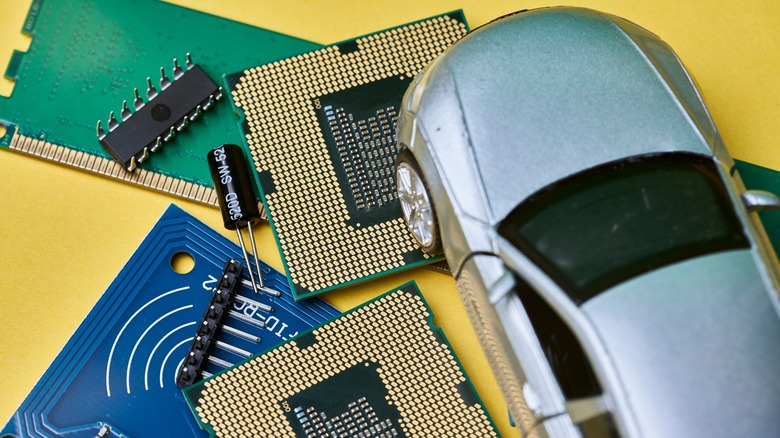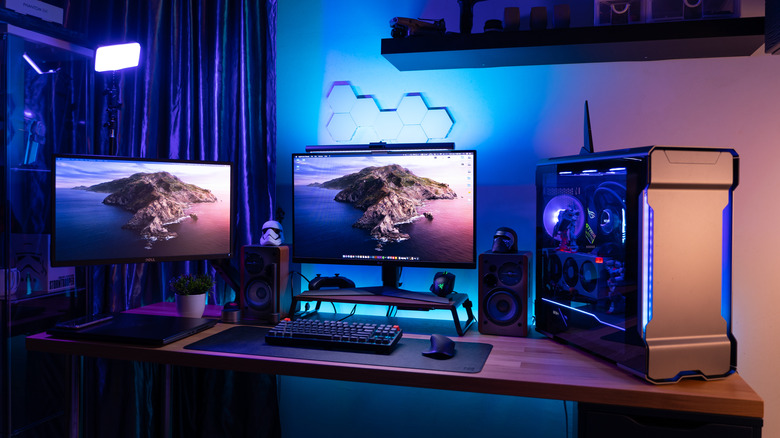When Will Graphics Cards Be Back In Stock? The Answer's Complicated
If you've been trying to get yourself a new PC or a laptop, or more precisely, a graphics card (GPU), you know more than well that the last two years have been dire. Many different reasons come together to create the ongoing chip shortage, and the graphics card market has been significantly affected. The prices are through the roof, the availability has been pretty scarce, and the outlook for the future has been grim. However, believe it or not, things are starting to look up.
Many aspiring PC builders currently feel like there is no hope for the market to ever recover. If you're the type of person to replace your PC once every few years, you'll see that you used to be able to build a whole gaming computer in 2017 for the price of just the graphics card in 2022. That's right: GPUs are currently ridiculously overpriced, and the supplies are still lacking, both of which can be attributed to the global chip shortage.
Even though it may seem bad now, we're already seeing improvements over 2021 and 2020, implying that the market may be slowly crawling out of this hole it has been stuck in for the past two years. Even if that proves to be accurate, what can we realistically hope for? Below, we will explore what caused the GPU shortage, what's currently happening, and how you can get a graphics card at a reasonable price right now.
What caused the graphics card shortage?
While graphics cards receive a lot of coverage due to inflated prices, the lack of GPUs is just one piece of a much larger puzzle. The global chip shortage has affected many markets and slowed down the production of countless devices, ranging from cars to gaming consoles and mobile phones. It may seem like we're dealing with something new here, but in fact, shortages and supply chain issues happen all the time. However, this time around, many various problems joined together to create one of the longest shortages the industry has ever known.
In order to produce new graphics cards, manufacturers such as Nvidia and AMD need chips. These are usually produced at semiconductor foundries, such as TSMC (pictured above), and silicon often has to be ordered months in advance. In addition to Nvidia and AMD, cards are produced by their board partners, such as Gigabyte, MSI, and Asus. Between all these manufacturers, as well as constant orders for new chips, you'd think it should be easy to maintain a stable market. However, when you take into consideration the past two years, it's equally easy to spot the wrench that was thrown into the mix: The COVID-19 pandemic.
The pandemic caused a massive rise in PC sales
As the number of coronavirus cases continued to rise all around the world, the market has been thrown into a constant state of flux. Many people were forced to stay home, remote work and learning became the norm, and those of us who preferred to spend time outside suddenly had to find ways to have fun while inside. This resulted in an unprecedented rise in PC sales that continues to this day. According to Business Wire, 2020 noted a 13.1% growth in PC sales compared to 2019.
We all know now that the pandemic hasn't ended, and thus, the market still hasn't recovered from the massive spike in demand that hit it early in 2020. Other than a rise in demand, supply chains all over the world were affected by the pandemic, noting delays in shipments and various other issues. To recap: people wanted to buy PC parts and PCs more than ever, the pandemic caused all manner of delays, and then, we've also got cryptocurrency miners.
Mining Ethereum, which is the most popular GPU-reliant currency to be mined, has been a thing long before the pandemic ever started. However, as crypto prices continued to rise, more and more mining operations wanted to buy more and more graphics cards. Combine that with a limited supply, and you've got a recipe for disaster, especially where regular users are concerned.
You can still buy GPUs - they're just very expensive
As the demand continued to grow, the supply of graphics cards became more and more scarce. In the midst of the pandemic, Nvidia has released its new line of graphics cards, dubbed the Nvidia GeForce RTX 3000 series. However, most users never got to get their hands on one because the cards, when restocked at MSRP, tend to sell out in seconds.
The one sure-fire way to get a GPU throughout the past two years has been to buy one from a scalper. Scalpers, often equipped with bots, snipe graphics cards as soon as they appear in stock and then re-sell them on various websites with a huge markup. As a result, regular retailers followed, upping the prices until they hit an all-time high. Many websites keep scores of how expensive the GPUs get, and 3DCenter, the source of regular reports about German and Austrian markets, sometimes noted price trends between one hundred and three hundred percent above the MSRP.
Fortunately, things have been starting to look up. We are finally starting to see the results of the many improvements GPU makers made to their supply chains. The supplies are on the rise, and as a result, the prices are beginning to normalize. Let's take a closer look at the state of the GPU market in 2021.
We're on the road to normalcy
Much like how the GPU shortage started due to a number of issues taking place all at once, it now seems that it will end in a similar way, thanks to a few different factors coming together. CEOs of all the tech giants involved in the GPU market, including Nvidia, AMD, and Intel, have spoken up about the shortage, and although they all were cautious about the state of the market in 2022, a theme of hope was prominent — a much-welcome change from previous predictions.
Nvidia and AMD are the key players on the GPU market, but Intel is soon set to join the fray, allegedly shipping up to 4 million discrete graphics cards in 2022. Nvidia and AMD will soon release their next-generation cards, but in the meantime, they continue producing current-gen models alongside their board partners, as well as releasing refreshed versions of these GPUs. This increase in stock levels is prominent and clearly visible in various reports, such as the latest information from 3DCenter.
Increasing supply levels are, unsurprisingly, tied to price drops. Nvidia GPUs reached their highest point at 318% of MSRP in May 2021, and they are now down to "just" 157% of MSRP. We are still miles away from normalcy, but we're getting there. There's another bit of happy news to add to the current state of things — cryptocurrency mining has been seeing a decline, both due to crypto pricing and the fact that Ethereum will soon move away from expensive GPU mining. As a result, we've got lowered demand, increased stock, prices which are slowly dropping, and many giants working to keep improving the situation. Even the Biden administration has invested massive amounts of money in fighting the semiconductor shortage.
When will the GPU shortage end?
All of that backstory paints a pretty dark picture of the GPU market, but as said above, things are starting to get better. While graphics cards sold at MSRP continue to sell out rapidly, you can buy a GPU at a markup from various retailers. It will still be expensive, but it will be more affordable than just a year ago. Current trends also point to normalizing prices, although that may take months instead of weeks.
A well-known Twitter leaker, Greymon55, thinks that we may see a drastic drop in GPU prices as early as March 2022. However, steadier information coming from sources such as Colette Kress, Nvidia CFO, points to the second half of the year as the time when the GPU shortage will ease up. On the other hand, Nvidia's CEO Jensen Huang said in 2021 that the majority of 2022 will continue suffering from supply constraints. As we get closer to the end of the year, we may continue seeing the prices drop. When Nvidia and AMD will release their next-gen graphics cards, joined by Intel's first-gen Arc Alchemist GPUs, chances are that the graphics cards will, for once, be fairly abundant.
It's worth remembering that no magic snap of fingers will end the GPU shortage. We will keep seeing small improvements, until one day, hopefully, we will reach a point where cards are sold near their MSRP on a regular basis, and building a PC is made possible once again. If you don't want to wait a few more months and don't mind spending a little extra, check out below as we tell you where to buy a graphics card in 2022.
Where to buy a graphics card in 2022?
Both Nvidia and AMD GPUs can be found on Amazon, and this applies to pretty much every country-specific version of the website. However, most of the time, these GPUs are sold at a premium, and they often come from scalpers, although that's not always the case. Even legit retailers sell the GPUs at an increased price. Why? Because they can. Here's an example of that: Nvidia is selling its own Founders Edition GeForce RTX 3090 for $2,400 on Amazon, whereas the GPU launched with an MSRP of $1,499.
GPUs such as that RTX 3090 are certainly discouraging, but if you dig deep, you can find better-priced graphics cards. Newegg is known for often stocking RTX 30-series graphics cards and the latest-and-greatest from AMD, such as this ASRock Radeon RX 6900 XT Phantom for $1,499. Some other U.S.-specific retailers worth checking include Best Buy, Walmart, BH Photo, and eBay — but keep in mind that eBay often has GPUs sold by scalpers. Best Buy sometimes restocks Nvidia GeForce RTX 30-series graphics cards at MSRP, but unfortunately, it has recently locked these sales behind a $200/year paywall through the Best Buy Total Tech membership.
Another option to check out is buying a pre-built PC. While pre-builds typically get a bad rep, if you buy from a known source and carefully check each component, you might be able to score a gaming PC cheaper than if you were to build it yourself. This is because PC manufacturers get better deals on components than the public does, and as a result, are able to produce slightly cheaper desktops. You can find gaming PCs on Amazon, Newegg, and at various other retailers. We recommend comparing prices to ensure you're getting the best deal possible.
To summarize the state of the GPU market: We're still on rocky waters, but slowly, we're getting close to the shore. Now is probably not the best time to buy a GPU, but if you're in a rush, you can get a graphics card without paying an arm and a leg. All it takes is a lot of market research, patience, and unfortunately, the willingness to pay more than the manufacturers initially intended.
